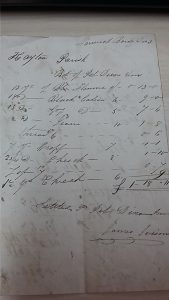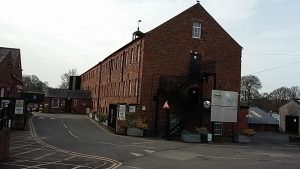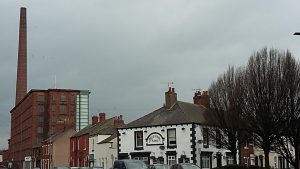Vouchers from Hayton Parish PR102/114/9-11 concern the purchase of textiles from Peter Dixon & Sons, Warwick Bridge.[1] The materials purchased included blue flannel, check, grey and black calico. Who the material was for is unstated, however, being of a darker cotton material, it was probably destined for the poor. Their clothes needed to be cheap, hard wearing and slow to show the dirt.

The mill at Warwick Bridge was called Langthwaite Cotton Mill built in 1790 and run initially by brothers John, Richard and George Ferguson. John died in 1802 and in 1809 Richard and George, offered the mill’s lease to their brother-in-law Peter Dixon (1753-1832).[2] Peter, a merchant from Whitehaven, had married their sister Mary Ferguson (1762-1814) in 1783. [3] Dixon took on the lease with his sons John (1785-1857), Peter (1789-1866) and George (1794-1860). Dixon’s other children were Richard (b.1788) , Ann (b.1792), Robert (b.1793) Joseph F. (b.1795), Frances (b.1797) Mary (b.1798) and Sarah (b.1800).[4] The brothers Peter and John bought extra land in order to enlarge the mill and improve its access to a good water supply. They built new cottages and provided employment for those living in the local area as well as a few residing in the poorhouse. [5] Women and children employed in the mill were paid 3s to 10s depending on their age. Peter Dixon died in 1832 and the sons sought to expand the business further as the textile industry expanded overall. Peter Dixon jun. was the most influential in the running of the mill.
In 1834 the Dixons bought land in Duke Street, Carlisle. They also bought nearby shops and houses to let to their workers. The cotton mill in Shaddongate and the accompanying chimney were completed on 25 October 1836.[6] At the time the chimney was the highest in the country. The mill was powered by steam rather than water. Production continued at Warwick Bridge, although the Dixons did try to sell the mill, without success staying and building further workers cottages and a school.

The Dixons appear to have tried to look after their workers, for example, building and supporting the school in Shaddongate, Carlisle.[7] They set aside land at both Warwick Bridge and Carlisle for gardens giving an annual premium to those with the best cultivated ground. By 1843 there were 120 cottage gardens at Warwick Bridge. [8]. A church was built at Warwick Bridge at the Dixons’ expense with free seats [9]. Following an outbreak of typhus in Warwick Bridge and the neighbourhood, Peter Dixon jun. made a cash donation of £20 to the House of Recovery in Carlisle. [10]
The Dixons built and lived in substantial residences themselves. Peter and his wife Sarah Rebecca Clark lived at Holme Eden Hall, Warwick Bridge, built around 1840; John and his wife Mary T Stordy at The Knells near Houghton built in 1826 . George and his wife Mary Boucher lived at Tullie House, Carlisle, his father Peter having bought it in 1825. The Dixons were influential in the politics of Carlisle , Peter and George serving terms as Mayor. By 1847 they had a further 2 mills at Cummersdale and Dalston along with the mills at Warwick Bridge and Shaddongate. In total, the Dixons employed about 8000 people.
Peter Dixon died 28 April 1866 and was buried in the grounds of Holme Eden Church. The Carlisle Journal reported that many villages came to the church to pay their respects not only to someone who had spent a long life amongst them but who had also shown them true acts of benevolence. [11] By 1872 the cotton industry was less profitable. Proceedings were begun for the liquidation of Peter Dixon & Sons.[12] Peter Dixon’s estate was sold, including Holme Eden Hall and the workers’ cottages at Burnrigg near Warwick Bridge. [13] Cotton production ceased at Warwick Bridge but the Dixon’s continued for a short while as a new limited company involved in the completion process of the textiles from the Shaddongate factory.
Most of the mills and buildings the Dixons built still exist today being adapted for differing purposes. The largest of which, Dixon’s chimney, is still a well known local landmark with a small tweed mill nearby. Ferguson Brothers opened a Mill at Holme Head, Carlisle in 1824. That building also survives.

Sources
[1] Cumbria Archives. PR102/114/9, Hayton Overseers’ Voucher, 15 February 1833; PR102/114/10, Hayton Overseers’ Voucher, 3 December 1833; PR102/114/11, Hayton Overseers’ Voucher,12 January 1833
[2] Mawson D.J.W., 1976 Longthwaite Cotton Mill. Transactions of Cumberland and Westmorland Antiquarian & Archeological Society p160-183
[3] Cumberland Paquet and Ware’s Whitehaven Advertiser, 9 September 1783
[4] www.ancestry.co.uk, accessed 15 February 2019
[5] Warwick Bridge and District Local History Group, Who worked at the Mill 1792-1845? (Open Doors Publishing, 2014)
[6] Carlisle Journal, 3 December 1836
[7] Carlisle Journal, 3 November 1838
[8] Carlisle Journal, 8 July 1843
[9] Carlisle Journal, 13 July 1844
[10] Carlisle Patriot, 10 December 1831
[11] Carlisle Journal, 8 May 1866
[12] The London Gazette, 19 July 1872
[13] The Whitehaven News, 17 July 1873